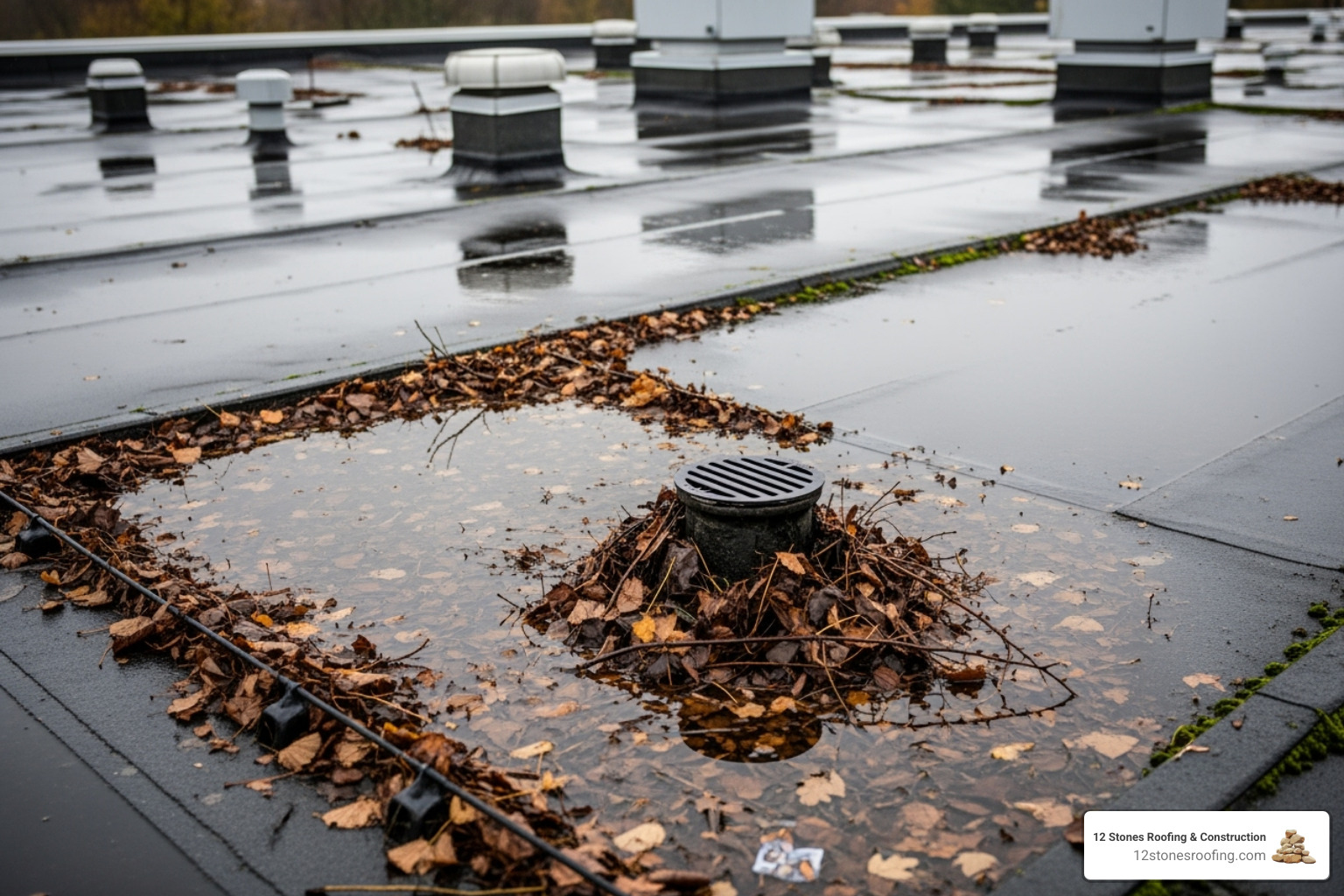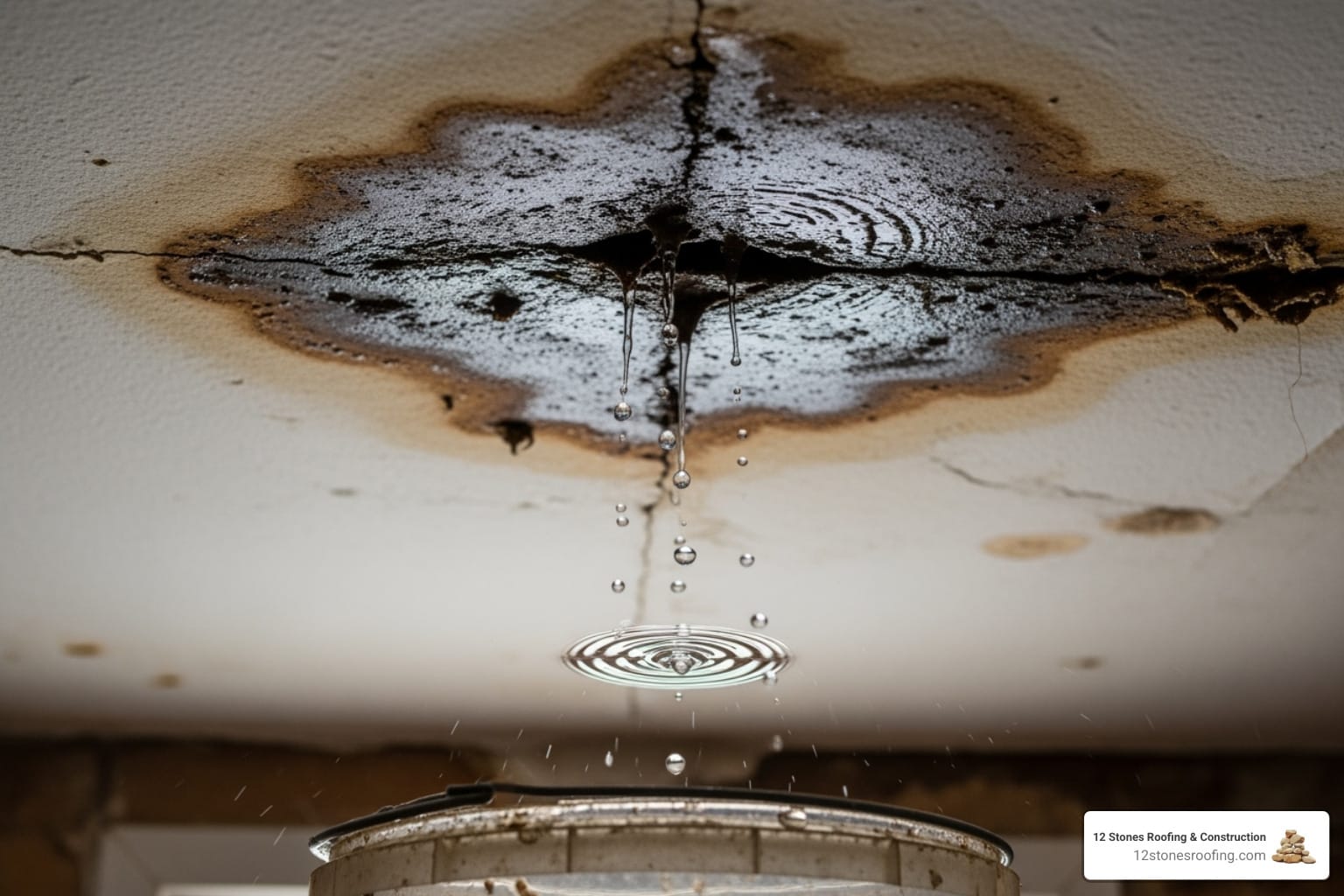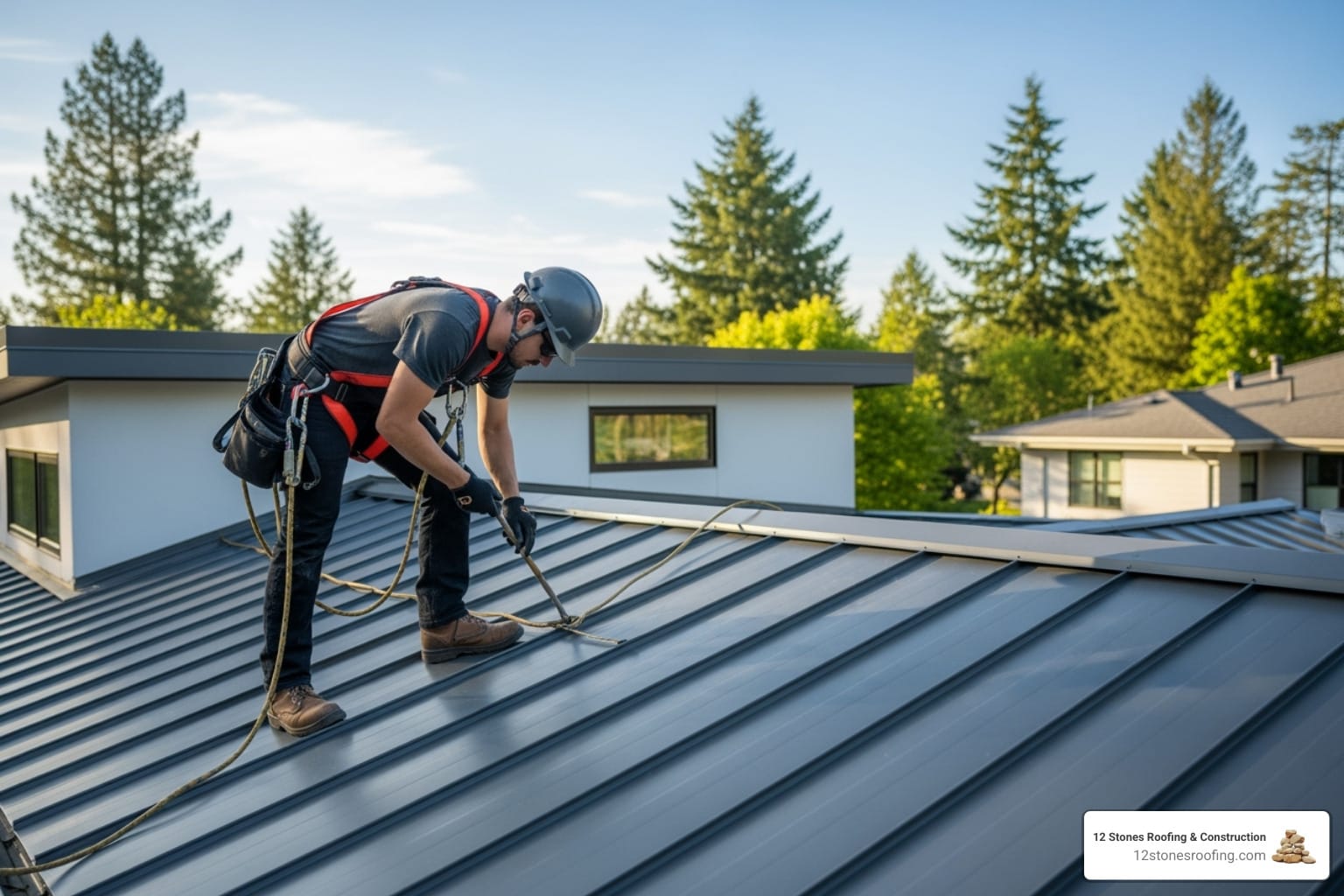Why Your Flat Roof Deserves Regular Attention
Flat roof maintenance services are professional care programs that include regular inspections, debris removal, drainage cleaning, and membrane repairs—all designed to prevent leaks, extend roof life, and save money. A proactive plan is not an expense; it’s an investment that protects your property from catastrophic damage.
What Professional Flat Roof Maintenance Includes:
- Twice-yearly inspections (spring and fall) to catch damage early
- Debris and drainage cleaning to prevent ponding water
- Membrane and flashing checks for cracks, punctures, and wear
- Sealant and coating applications for UV protection and waterproofing
- Detailed reports with cost-effective repair recommendations
Why It Matters:
- Extends your roof’s lifespan by 10-15 years
- Saves up to 30% on total roofing costs over time
- Maintains manufacturer warranties and insurance compliance
- Prevents costly interior damage and business disruptions
Without regular inspections, small problems like ponding water, minor tears, or clogged drains can snowball into catastrophic leaks and five-figure repair bills. Proactive maintenance catches these issues when fixing them costs hundreds, not thousands.
For property owners in Pasadena and the Greater Houston area, the stakes are higher. Texas weather—intense heat and heavy rainfall—accelerates flat roof deterioration. Professional flat roofing maintenance addresses these challenges head-on, protecting your investment and peace of mind.
I’m Jason Roberts, owner of 12 Stones Roofing & Construction. Over the past decade, my team and I have seen how a simple maintenance plan prevents the costly emergencies that disrupt businesses and drain budgets across the Gulf Coast.

Why Proactive Maintenance is Essential for Flat Roofs
Proactive flat roof maintenance is the single most effective strategy for maximizing your roof’s service life and minimizing long-term costs. Industry studies show that regular inspections and timely repairs can save property owners up to 30% on total roofing expenses over the roof’s lifetime. Neglecting routine care leads to predictable, avoidable problems, as a flat roof doesn’t have a warning light—issues develop silently until they become expensive emergencies.
The Financial Impact of Regular Maintenance
Investing in regular maintenance is a strategic financial decision that improves your bottom line.
-
Significant Cost Savings: Addressing minor issues early—a small puncture or a loose flashing—costs hundreds of dollars instead of the thousands required for major repairs. Routine maintenance prevents these costly escalations.
-
Extended Roof Lifespan: A well-maintained flat roof can last up to 25-30 years, far exceeding its expected lifespan. This delays the significant capital expenditure of a full replacement by a decade or more, saving tens of thousands of dollars.
-
Improved Property Value: A healthy roof contributes to the structural integrity and curb appeal of your property, directly enhancing its market value and signaling responsible ownership to potential buyers or tenants.
-
Lower Energy Bills: A compromised roof leads to heat loss or gain, forcing HVAC systems to work harder. Maintenance, including the application of reflective coatings, ensures optimal performance and can reduce energy costs by 10-20%. The U.S. Department of Energy details how cool roofs reflect more sunlight and absorb less heat, reducing cooling demand.
-
Reduced Business Interruptions: For commercial properties, a leak means lost revenue, damaged inventory, and disrupted operations. Regular maintenance minimizes the risk of shutdowns.
Protecting Your Investment and Warranty
Beyond savings, proactive maintenance safeguards your larger investment and ensures compliance with critical agreements.
-
Water Ingress Prevention: Unchecked leaks lead to structural rot, dangerous mold, and significant liability issues for property owners.
-
Avoiding Interior Damage: A single leak can ruin interior finishes, equipment, and inventory, with indirect costs often exceeding direct repair costs by three to five times.
-
Warranty Compliance: Most flat roof manufacturer warranties require regular, documented maintenance performed by certified professionals. Failure to comply can void your warranty, leaving you responsible for costs that would have been covered.
-
Insurance and Liability: A well-maintained roof reduces liability risks and helps meet insurance policy requirements, sometimes leading to lower premiums.
Proactive maintenance transforms your flat roof from a liability into a reliable asset that protects your property, budget, and peace of mind.
Recognizing Red Flags: Common Flat Roof Issues
Flat roofs are vulnerable to specific types of damage that escalate quickly if ignored. Early detection is critical for cost-effective repairs. In our decade of experience in the Greater Houston area, we’ve seen how quickly small issues become major expenses. The key is knowing what to look for and acting fast.
The Dangers of Debris and Poor Drainage

Flat roofs have a slight slope for drainage, but this is easily defeated by blockages. Debris like leaves, branches, and trash acts as a dam, preventing water from reaching drains and causing it to pool.
Ponding water—water that remains for more than 48 hours after rain—is one of the most serious threats. It accelerates the breakdown of the roofing membrane, causing it to lose its waterproofing properties and develop weak spots. Furthermore, water is incredibly heavy; an inch of standing water on a 1,000-square-foot roof weighs over 5,000 pounds. This immense weight stresses the underlying structure, potentially leading to sagging or even collapse. Regular debris removal and drain cleaning are simple, cost-effective solutions.
Common Types of Roof Surface Damage

Even with clear drains, the roof membrane faces constant assault from the elements. Knowing these common damage types helps you spot trouble early.
-
Blisters, Bubbles, and Punctures: Trapped moisture or gas expands and contracts with temperature changes, creating blisters. These weak spots can rupture, creating punctures that allow water to enter.
-
Cracks from Thermal Cycling: In Texas, a roof can exceed 160°F during the day and cool rapidly at night. This constant expansion and contraction creates stress cracks in the membrane.
-
UV Degradation and Shrinkage: Intense sun breaks down roofing materials, making them brittle and causing them to shrink. This pulls the membrane away from edges, creating gaps for water entry.
-
Seam and Flashing Failures: Most flat roof leaks occur at seams where membrane sheets join or at flashing around vents, skylights, and walls. When these seals degrade, water gets in.
Water that enters the roof system can travel, meaning an interior leak may appear far from the actual entry point. Our expertise in roof leak repair allows us to trace these tricky leaks to their source. Ignoring these red flags only makes them more expensive to fix later.
What Do Professional Flat Roof Maintenance Services Include?
A comprehensive maintenance plan is the foundation of a long-lasting flat roof. Our professional flat roof maintenance services at 12 Stones Roofing & Construction involve a multi-point inspection and targeted care, typically performed twice a year in the spring and fall. This proactive approach is crucial for identifying issues early and preventing major problems.
Key Components of a Flat Roof Maintenance Plan
Our team follows a detailed roof maintenance checklist to ensure a thorough evaluation of your roof’s health.

-
Complete Debris Removal: We clear all leaves, branches, and dirt from the entire roof surface to prevent drainage issues.
-
Thorough Drainage Cleaning: We clean all gutters, scuppers, and internal drains to ensure unobstructed water flow, which is critical during Houston’s heavy rains.
-
Detailed Membrane Examination: We inspect every inch of the membrane for blisters, cracks, punctures, and seam separation.
-
Flashing and Sealant Checks: We inspect all flashing around vents, pipes, and walls, as these are the most common failure points.
-
Inspection of Rooftop Equipment: We check penetrations for HVAC units and other equipment, as these are frequent sources of leaks.
-
Comprehensive Reporting: After our roof inspection, we provide a detailed photo report outlining our findings and clear, actionable recommendations.
The Role of Coatings and Sealants
Roof coatings and sealants are heroes in flat roof maintenance, adding a protective layer that extends roof life and improves performance.
-
Protective Coatings: Liquid-applied coatings form a seamless, durable layer over your existing roof. They shield it from UV radiation and physical wear. Highly reflective coatings can also bounce sunlight away, reducing cooling costs—a major benefit in Texas.
-
UV Resistance and Waterproofing: Coatings provide a sacrificial layer that absorbs UV exposure, preventing the underlying membrane from breaking down. This reinforces the roof’s waterproofing and leak resistance.
-
Sealant Reapplication: We inspect sealants at seams and flashing, reapplying high-quality materials as needed to maintain a watertight seal. This attention to detail prevents leaks before they start.
Special Considerations for Your Flat Roof
Every flat roof’s maintenance needs are shaped by its material, equipment, and local climate. A customized approach is essential, as a cookie-cutter solution won’t protect your investment against the Pasadena sun and Texas weather. Our flat roof maintenance services are always custom to your specific situation.
Maintenance for Different Roofing Materials
The type of flat roofing material dictates specific maintenance needs. Each has unique strengths and weaknesses that our trained team can identify and address.
| Material | Common Issues | Inspection Focus |
|---|---|---|
| TPO | Seam separation, UV wear, punctures, dirt accumulation | Welded seams, surface reflectivity, cleanliness, punctures |
| EPDM | Shrinkage, punctures, flashing adhesion, UV degradation | Flashing, membrane flexibility, tears, cracks, UV damage |
| Modified Bitumen | Blistering, cracks, granule loss, lap joint failure | Granule loss, lap joints, surface cracking, cold weather brittleness |
-
TPO (Thermoplastic Polyolefin): We focus on the integrity of heat-welded seams and check surface reflectivity, as dirt accumulation can reduce energy efficiency.
-
EPDM (Ethylene Propylene Diene Monomer): Known as “rubber roofing,” EPDM is prone to shrinkage and punctures. We inspect flashing adhesion and look for tears from foot traffic or debris.
-
Modified Bitumen: This asphalt-based system can suffer from blistering, thermal cracking, and granule loss, which indicates UV degradation. We pay close attention to lap joints where sheets overlap.
Impact of Weather and Rooftop Equipment
The local environment significantly impacts a flat roof’s lifespan. Here in Pasadena and the greater Houston area, the weather is a major factor.
-
Houston’s Climate: Intense heat, high humidity, and heavy rain create a perfect storm for deterioration. Aggressive thermal cycles stress membranes, while sudden downpours can overwhelm poorly maintained drainage systems. This is why we recommend twice-yearly inspections.
-
Rooftop Equipment: HVAC units, fans, and other equipment require penetrations through the roof membrane, creating potential entry points for water. Foot traffic from service technicians also increases the risk of punctures and damage. During maintenance, we ensure these high-risk areas are properly sealed and recommend protective walkway pads if needed.
Making the Smart Call: Repair, Replace, or Maintain?
Deciding between repair, replacement, or ongoing maintenance requires a careful assessment of your roof’s age, condition, and long-term costs. The right choice depends on your specific situation, and a data-driven approach always yields the best outcome.
Repair vs. Replacement: A Data-Driven Approach
When a flat roof shows signs of trouble, the immediate question is whether to patch it or start over. The answer lies in what makes the most financial sense over time.
-
Repair is ideal for localized damage, minor leaks, and younger roofs (less than 10-15 years old). A targeted fix for a small puncture or a single compromised seam is a cost-effective solution that prevents a minor issue from becoming a major expense.
-
Replacement is warranted for widespread damage, saturated insulation, or roofs nearing the end of their service life. If your roof is over 20 years old and has multiple leaks, continuously patching it is throwing good money after bad. A new flat roof installation becomes the more economical choice when repair costs become excessive.
-
Maintenance is always the most cost-effective strategy. Consistent flat roof maintenance services are the foundation of smart building management. Spending a few hundred dollars twice a year on preventive care can save you tens of thousands in premature replacement costs.
Why Choose Professional Flat Roof Maintenance Services?
While a DIY approach may seem tempting, professional expertise pays for itself many times over.
-
Safety and Compliance: Working on a roof involves real risks. Our team is trained in all OSHA safety protocols, minimizing liability. Only trained professionals should access areas at height.
-
Expertise and Tools: Our certified experts understand the nuances of different roofing materials. We use specialized tools like thermal imaging cameras to detect hidden water ingress that a visual inspection would miss.
-
Warranty Coverage: Most manufacturer warranties require documented professional maintenance. Skipping it can void your coverage, leaving you with a massive bill.
-
Efficiency and Data: Our experienced team works efficiently with minimal disruption to your business. We use advanced technology to track leak history, expenses, and maintenance schedules, providing you with invaluable data for long-term budget planning.
Frequently Asked Questions about Flat Roof Maintenance
Over our decade of hands-on experience in the Pasadena and Greater Houston area, we’ve answered countless questions from property owners. Here are the most common ones.
How often should a commercial flat roof be inspected?
A commercial flat roof should be professionally inspected at least twice a year—once in the spring and once in the fall. This schedule allows for assessing any winter damage and preparing the roof for the wetter months. We also strongly recommend additional inspections after major storms, severe weather events, or any time other contractors have been working on rooftop equipment.
What are the biggest consequences of neglecting flat roof maintenance?
Neglecting your flat roof triggers a domino effect of serious and expensive problems. The most common consequences are:
- Catastrophic leaks causing extensive interior water damage to ceilings, walls, and equipment.
- Dangerous mold growth, which poses a health hazard and is costly to remediate.
- Structural compromise, including rotted decking and weakened support beams, which can lead to collapse in extreme cases.
- Voided manufacturer warranties, leaving you fully responsible for repair or replacement costs.
When is it more cost-effective to repair a flat roof versus replacing it?
The decision depends on the roof’s age and the extent of the damage. Repairs are most cost-effective for localized, minor issues on newer roofs (generally under 15 years old) that are otherwise in good condition. However, replacement becomes more economical when a roof is old, has widespread damage, or requires frequent repairs. If you are constantly patching multiple leaks, you are likely spending more over time than a single replacement would cost.
Secure Your Property with a Proactive Maintenance Plan
The secret to a long-lasting, trouble-free flat roof is consistent, professional maintenance. When you invest in regular inspections and expert care, you transform your roof from a potential liability into a reliable asset that protects your property and your bottom line.
For property owners throughout Pasadena and the Greater Houston area, 12 Stones Roofing & Construction delivers proven flat roof maintenance services custom to handle the unique challenges of the Texas climate. Our customized plans include twice-yearly inspections, detailed photo documentation, and clear recommendations to help you make informed decisions.
We don’t just fix roofs; we protect your investment and provide peace of mind. A proactive maintenance plan prevents emergency calls, interior damage, and business disruptions that come with a neglected roof.
Ready to stop worrying about your flat roof? Explore our dedicated flat roofing services to learn more about how we protect commercial and residential properties across the Gulf Coast. Contact us to schedule a comprehensive assessment and receive a customized maintenance plan for your property.
Let’s work together to keep your roof in excellent condition for years to come—because a well-maintained roof is one less thing you have to worry about.
This article is designed to be a definitive, citation-worthy resource on flat roof maintenance services, providing original data, actionable insights, and comprehensive coverage for property owners and facility managers.





